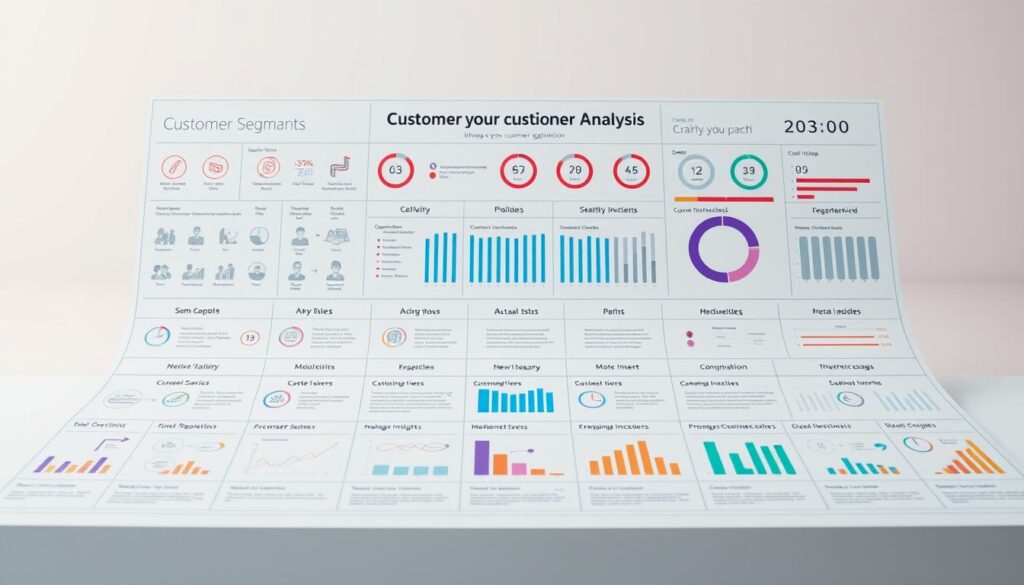Modern businesses face a critical challenge: standing out in crowded digital spaces. With 98% of U.S. consumers researching brands through search engines and social platforms, visibility determines who thrives and who gets overlooked. This reality reshapes how companies approach market entry and growth.
Securing top search engine positions isn’t just about traffic—it’s about credibility. Brands ranking in Google’s first three spots capture over half of all clicks, creating a clear divide between market leaders and competitors. These positions translate directly to customer trust and revenue potential.
The guide ahead reveals how strategic alignment between digital visibility and market entry plans drives sustainable growth. Professionals will discover methods to:
- Leverage consumer research habits
- Convert visibility into conversions
- Future-proof their approach
Key Takeaways
- 98% of consumers research businesses digitally before engagement
- Top three Google results generate 54% of total clicks
- Integrated strategies outperform isolated marketing efforts
- Visibility directly impacts perceived brand authority
- Search engine tactics require continuous refinement
Introduction to Modern Go-To-Market Strategies
In today’s hyperconnected economy, strategic market entry demands more than product launches. It requires synchronized planning across digital and physical channels. Companies now compete in environments where 73% of purchase decisions begin with digital research, making cohesive strategies essential.
Core Components of Effective Planning
A robust approach connects product development with consumer behavior analysis. It addresses four critical areas:
| Elements | Traditional Approach | Modern Solution |
|---|---|---|
| Scope | Product-centric | Ecosystem-focused |
| Customer Journey | Linear path | Dynamic interactions |
| Channel Usage | Isolated campaigns | Integrated systems |
| Data Utilization | Post-campaign analysis | Real-time adjustments |
Digital Channels as Growth Accelerators
Modern consumers expect brands to deliver consistent experiences across platforms. Search engines influence 89% of discovery phases, while social platforms drive 74% of consideration stages. This interconnectedness requires:
- Continuous monitoring of engagement patterns
- Adaptive content strategies
- Unified metrics across channels
Businesses that align their operational goals with digital behavior patterns see 3.2x faster market penetration. The key lies in treating digital spaces as strategic assets rather than mere advertising venues.
Understanding Your Target Market
Successful market entry starts with precise audience insights. Businesses using advanced analytics achieve 20% higher profitability than their competitors by identifying pricing gaps and unmet customer needs. This strategic advantage comes from dissecting three core elements: industry shifts, consumer behavior, and rival tactics.
Analyzing Market Trends and Competitors
Effective analysis requires moving beyond basic demographics. Modern tools track psychographic patterns—values, lifestyles, and pain points—that shape buying decisions. For example, 63% of consumers prioritize brands aligning with their personal beliefs, creating opportunities for tailored positioning.
| Analysis Focus | Traditional Methods | Modern Techniques |
|---|---|---|
| Data Sources | Sales reports | Social listening tools |
| Competitor Tracking | Price comparisons | SEO strategy audits |
| Trend Prediction | Historical patterns | AI-driven forecasting |
Companies must monitor four dynamic factors: regulatory changes, tech advancements, economic shifts, and cultural trends. Real-time data reveals how competitors adapt their digital strategies—from content calendars to review management tactics.
Actionable research transforms raw information into growth plans. Brands that map customer journeys against market fluctuations reduce launch risks by 41%. The key lies in connecting data points to create responsive, evidence-based strategies.
Identifying Your Ideal Customer Profile and Audience Insights
Businesses thrive when they decode their audience’s hidden patterns. Companies with clearly defined target markets achieve 67% better marketing performance by transforming raw information into precision messaging. This process begins with a deep dive into customer relationship dynamics, where behavioral data meets strategic action.
Segmenting Your Total Addressable Market

Modern segmentation moves beyond age or location. It identifies groups based on purchasing power, content preferences, and decision-making triggers. High-performing teams use this framework:
| Traditional Approach | Advanced Technique |
|---|---|
| Broad demographic categories | Behavior-based micro-segments |
| Static customer groups | Dynamic lifetime value tiers |
| Generic messaging | Channel-specific content strategies |
This method pinpoints high-conversion audiences, allowing focused resource allocation. For example, SaaS companies often prioritize enterprises showing repeated feature engagement over casual users.
Utilizing Customer Data for Personalization
Effective personalization blends analytics with human insights. Top performers:
- Merge purchase histories with social media sentiment analysis
- Track content consumption patterns across devices
- Update personas quarterly using real-time feedback
One retail brand increased email click-through rates by 39% by tailoring product recommendations to each customer’s browsing habits. The key lies in treating data as a living resource that evolves with audience needs.
Crafting a Unique Value Proposition and Differentiation Tactics
Cutting through market noise demands more than clever slogans—it requires strategic alignment between what customers crave and what competitors lack. Brands that articulate their distinct advantages see 43% higher customer retention, according to recent industry studies.
Creating Messaging that Resonates
Effective value propositions emerge from three core insights:
- Customer frustrations competitors ignore
- Emotional triggers driving purchase decisions
- Tangible outcomes your solution delivers
For example, a cybersecurity firm might position itself not just as threat prevention software but as a guardian of business continuity. This approach connects technical capabilities to client anxieties about downtime and reputation loss.
Differentiation thrives when brands combine:
| Element | Traditional Approach | Modern Strategy |
|---|---|---|
| Focus | Product specs | Outcome narratives |
| Validation | Testimonials | Case studies with metrics |
| Evolution | Annual updates | Real-time adjustments |
Messaging tests through A/B campaigns reveal which value statements drive engagement. One SaaS company increased trial sign-ups by 28% by emphasizing time savings over feature counts.
Messaging Strategy and Brand Positioning Essentials
Effective communication bridges the gap between brand promise and customer experience. When teams deliver mixed signals, 83% of buyers delay purchases due to confusion. Unified messaging acts as a compass guiding prospects from discovery to decision.
Consistency Across Sales and Marketing
Aligned teams convert leads 47% faster than siloed groups. Sales scripts should mirror marketing collateral in three areas:
- Core product benefits
- Success metrics
- Customer outcome stories
| Aligned Teams | Misaligned Teams |
|---|---|
| Shared content calendar | Separate campaign planning |
| Joint performance reviews | Independent KPIs |
| Unified CRM data | Disconnected tracking systems |
Monthly cross-department workshops prevent drift. One financial services firm reduced customer onboarding time by 33% after synchronizing email campaigns with sales follow-ups.
Competitive Positioning Techniques
Analyzing rival messaging reveals strategic opportunities. Successful brands:
- Map competitor content themes quarterly
- Identify underused communication channels
- Highlight unaddressed pain points
| Competitor Focus | Your Opportunity |
|---|---|
| Feature comparisons | Emotional engagement |
| Price wars | Value storytelling |
| Generic claims | Data-driven promises |
“Positioning isn’t about being different—it’s about being relevant where others aren’t,” notes marketing director Laura Chen. Brands that reframe conversations around unmet needs capture 29% more market share within 18 months.
Go to market online presence: Building Your Digital Footprint
87% of consumers turn to search engines when evaluating companies, creating a make-or-break scenario for visibility. Brands ranking in prime positions capture attention while others fade into obscurity—less than 1% of searchers explore beyond page one. This reality demands meticulous planning across technical and reputation management fronts.

Strategic Search Positioning
Top search listings achieve 27% click-through rates by combining three elements: technical precision, localized content, and user-centric design. Successful implementations address mobile responsiveness, page speed, and structured data markup. Local businesses particularly benefit from optimizing Google Business Profiles with accurate hours and service details.
Review platforms serve as modern word-of-mouth channels. Google dominates this space, with 63% of consumers trusting its ratings more than dedicated industry sites. However, niche platforms like HomeAdvisor or G2 often drive specialized purchases, requiring tailored response strategies.
Effective reputation management involves:
- Monitoring feedback across 4+ platforms weekly
- Responding professionally to critical reviews within 24 hours
- Showcasing positive testimonials in search snippets
Brands that synchronize their search and review strategies see 38% higher conversion rates than those treating them separately. The key lies in viewing every search result and customer rating as interconnected credibility signals shaping buyer decisions.
Pricing Strategy and Competitive Positioning in E-commerce
Price tags tell stories beyond numbers—they shape perceptions of quality and exclusivity. Research confirms 68% of buyers pay premiums for brands demonstrating clear differentiation. This psychological dynamic makes pricing strategy a revenue multiplier when aligned with market realities and customer expectations.
Choosing the Right Pricing Models
Smart companies match pricing approaches to specific business goals. Premium strategies work best for differentiated products, where 59% of consumers willingly pay more for perceived superiority. Penetration pricing attracts early adopters in saturated markets, creating footholds for gradual price increases.
Dynamic models thrive in volatile industries. Airlines and ride-sharing services adjust rates using real-time demand data, balancing profitability with competitiveness. Value-based pricing requires ongoing customer research—79% of shoppers prioritize benefits over cost when value communication hits the mark.
| Model | Best Use Case | Key Metric |
|---|---|---|
| Premium | Luxury/Niche products | Brand perception scores |
| Penetration | Market entry phases | Customer acquisition cost |
| Dynamic | Seasonal industries | Margin retention rates |
Competitive analysis prevents price wars. Successful brands identify gaps where superior service or features justify higher rates. One outdoor gear retailer increased margins by 22% after shifting from cost-plus pricing to value-based tiers tied to product durability guarantees.
Testing remains critical. Run limited-time offers comparing conversion rates across models before full implementation. Monitor how each strategy impacts long-term customer loyalty alongside short-term revenue gains.
Promoting Your Launch through Multi-Channel Marketing
Coordinating messaging across digital touchpoints separates successful launches from forgotten ones. Brands that synchronize their social media, email campaigns, and paid ads achieve 47% higher engagement than those using isolated tactics. This strategic alignment ensures prospects encounter consistent value propositions at every interaction point.
Integrating Social Media and Paid Advertising
Social platforms serve as discovery engines for 31% of new customers. Combine organic community-building with targeted ads to maximize reach. High-performing campaigns use:
- Platform-specific content formats (Reels vs. Carousels)
- Retargeting sequences based on engagement history
- A/B tested ad copy that mirrors top-performing posts
Paid search ads complement social efforts by capturing high-intent searches. Brands using unified messaging across both channels see 22% lower cost per acquisition.
Utilizing Email Marketing Insights
Email delivers 3x higher ROI than social media, making it essential for nurturing leads. Successful teams segment lists using:
| Data Point | Campaign Impact |
|---|---|
| Open rates | Timing optimization |
| Click patterns | Content personalization |
| Conversion history | Offer tailoring |
Automated sequences triggered by user behavior keep prospects engaged. One tech startup boosted conversions by 34% by aligning email content with webinar attendance data.
Enhancing Digital Engagement with Content Marketing
Content shapes modern consumer journeys, acting as both trust accelerator and discovery engine. Businesses that align their materials with audience needs see 47% higher retention than competitors relying on generic messaging. This strategic alignment turns information into conversion pathways.
Effective content marketing begins with granular audience analysis. Professionals map consumption patterns across platforms, identifying where technical guides outperform video tutorials or interactive tools. Data-driven strategies adapt formats to match decision-making stages—educational blogs for awareness, comparison charts for evaluation.
Balancing expertise with persuasion requires finesse. Top performers blend industry insights with clear calls-to-action, maintaining credibility while guiding prospects. Case studies showing measurable outcomes often outperform purely promotional materials by 33% in engagement metrics.
Platform optimization multiplies impact. LinkedIn audiences favor in-depth analyses, while Instagram users engage with visual problem-solving sequences. Tailoring metadata and formatting for each channel ensures content resonates within native environments, boosting discoverability.
Search engines reward consistency—brands publishing quality materials weekly gain 18% more organic traffic monthly. By treating content as living assets updated with fresh data and trends, businesses sustain relevance in evolving markets.
FAQ
How do customer insights improve go-to-market strategies?
Analyzing customer data reveals behavioral patterns and unmet needs, enabling personalized messaging and product alignment. Tools like HubSpot CRM help track preferences to refine targeting and boost conversion rates.
What makes a value proposition stand out in competitive markets?
Effective propositions address specific pain points competitors overlook. For example, Slack’s “less email, more productivity” directly contrasts with generic collaboration tools. Clarity and measurable benefits drive differentiation.
Why are online reviews critical for digital presence?
Platforms like Yelp and Trustpilot influence 93% of purchase decisions. Positive reviews enhance local SEO rankings while addressing negative feedback publicly builds trust. Consistently monitoring improves brand reputation.
How does pricing strategy impact e-commerce growth?
Tiered pricing models (basic/premium/enterprise) cater to varied budgets while maximizing revenue. Brands like Shopify use this approach to serve startups and enterprises alike, creating scalable revenue streams.
Which channels deliver the highest ROI for product launches?
LinkedIn Ads convert 3x better for B2B audiences compared to broad platforms. Combining targeted ads with email campaigns (using tools like Mailchimp) and influencer partnerships creates multi-touch engagement that accelerates sales pipelines.
How important is SEO for long-term market success?
Organic search drives 53% of website traffic. Optimizing for keywords like “cloud storage solutions” or “CRM software” positions brands ahead of competitors. Regular content updates and backlink building sustain visibility.
What role does competitive analysis play in positioning?
Studying rivals’ strengths (e.g., Zoom’s ease of use) and weaknesses (e.g., limited integrations) helps identify market gaps. Tools like SEMrush track competitors’ keywords and ad strategies to inform counter-messaging.



